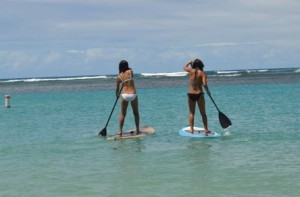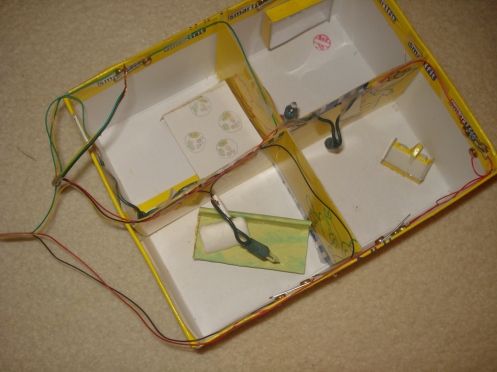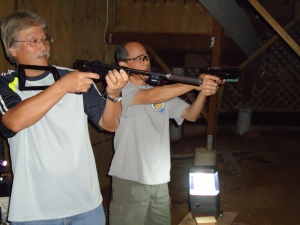In eighth grade, we briefly covered the topic of circuitry. I did not fully understand how a parallel and series circuit worked, and didn’t quite grasp the relationships between resistance, potential difference, and current. However, we were given an assignment to make a house out of a shoe box with different rooms. Using two D batteries, four bulbs, paper clips for switches, brass fasteners, and wires, we were to make each room light up with the flip of a switch. The brass fasteners held the paper clip switches in place, which worked well since both the fasteners and the paper clips are sufficient conductors of electricity. Although the wiring seemed complicated to me at the time, I now realize that each room was simply an individual series circuit. The bulb in one room had one wire intertwined with one wire of the bulbs in the other rooms. The bundle of four wires could then be attached to the positive end of the battery. The other wire of the bulb was intertwined with the other side of wires in the other bulbs, and that bundle could be attached to the negative end of the battery, creating complete circuits. The switches were placed in between the bulbs and the battery. To create the switch, one end of the paper clip was secured to the brass fastener, allowing it to pivot. On the other side of the paper clip, another brass fastener was screwed into the box. When the paper clip was touching both fasteners, it created a complete circuit and the bulb lit. When one end of the paper clip was detached from the fastener, it created a break in the circuit and the bulb was not able to receive the flow of electrons and did not light up.
Often when I do the laundry, my clothes get stuck together in the dryer. This is all due to static cling, which is a result of electrostatics. Since water molecules reduce charges, the clothes are more likely to become charged in the presence of the dry (low humidity) air of the dryer. We know that the clothes become charged as a result of rubbing against each other because they stick together, and therefore must have opposite charges (opposite charges attract each other). The opposite charges are attained when the clothes rub against each other and transfer electrons. We cannot be certain whether a piece of clothing is negatively or positively charged since both will stick to your neutrally charged hand. If a piece of clothing is negatively charged, it will repel the electrons in your hand, leaving the side closest to the clothing more positive, and thus sticking to you. If a piece of clothing is positively charged, it will attract the electrons in your hand and leave the side closest to the clothing more negative, thus sticking to you as well. A way in which we can be certain whether a piece of clothing is positively or negatively charged, is if we rubbed a plastic pen in our hair (making it negatively charged) and determining if it repels or attracts a piece of clothing. If the clothes are repelled by the pen, it is negatively charged. Conversely, if the clothes are attracted to the pen, it is positively charged.
This is a picture of a roller coaster that I rode in California. At one point during the ride, the riders go upside down in a loop. In class, we learned that roller coaster loops are more of an oval than a circle since the velocity toward the bottom would be much greater if the cart traveled in a perfect circle, and would also be much more uncomfortable for the riders. Also, we learned how to calculate the acceleration, velocity, and force on the cart at any point of the loop if it were a perfect circle.

As the apple falls from the tree, we can calculate the work done by gravity on the apple, which is (mass of the apple)(10)(height of the apple’s descent). We can also calculate the negative work of air friction done on the apple as it falls. When the work of gravity and the work of air friction is added, we are able to find the net work done on the apple.
Physics can be easily incorporated into this image of my dad and his friend shooting bb guns. As the bullet leaves the gun, we learned that the horizontal acceleration is zero, and vertical acceleration is -9.8 m/s^2. With an addition to further information, we can calculate the horizontal distance traveled by the bullets.
Whenever we have to go to the field for my brother’s soccer practice, my sister and I sometimes keep ourselves occupied by climbing the trees. If I were to draw a free-body diagram for my sister, it would include a downward force of gravity, as well as an equal and opposite force of the tree pushing upward against her hands and legs. Because the forces are equal, she neither accelerates downward nor is she pulled upward by the tree.
My younger brother enjoys playing soccer. A few summers ago, he played in an AYSO soccer tournament. This picture illustrates the physics that is involved in something so ordinary as soccer. After my brother kicks the ball, the ball should continue to roll until it is stopped by a net outside force. This is explained by Newton’s First Law, which states that “an object at rest remains at rest, and an object in motion remains in motion at a constant velocity unless acted upon by a net outside force.” However, although the ball should continue to roll at a constant velocity, it eventually decelerates and comes to a stop. This is because there is friction as the ball rolls on the grass. It just comes to show that physics appears in everyday exercises such as soccer.
This summer, my friends and I tried stand-up paddle boarding for the first time. After gaining better control of our balance, we decided to race each other. During the time we were racing, the concept of physics had never crossed my mind. However, now that I consider it, physics can easily relate to paddle boarding. First of all, Newton’s Third Law plays an active role in paddle boarding. “For every action, there is an equal and opposite reaction.” When the person paddles, the paddle pushes against the water, and in reaction, the water also pushes the paddle with an equal and opposite force. As this happens, the concept of acceleration and velocity also takes part in paddle boarding. When the paddle pushes against the water and vice versa, the board accelerates forward. By continuing to paddle, the board accelerates at an increasing velocity. Similarly, if one were to stop paddling, the board would accelerate at a decreasing speed. Until today, the relationship between paddle boarding and physics had never occurred to me.
Welcome to WordPress.com. After you read this, you should delete and write your own post, with a new title above. Or hit Add New on the left (of the admin dashboard) to start a fresh post.
Here are some suggestions for your first post.
- You can find new ideas for what to blog about by reading the Daily Post.
- Add PressThis to your browser. It creates a new blog post for you about any interesting page you read on the web.
- Make some changes to this page, and then hit preview on the right. You can always preview any post or edit it before you share it to the world.






